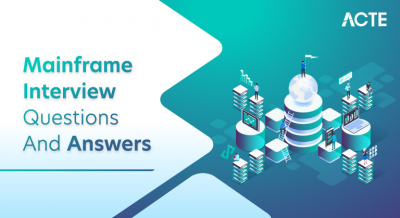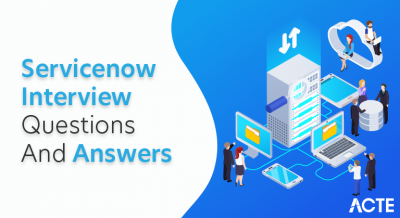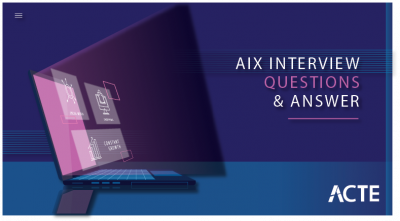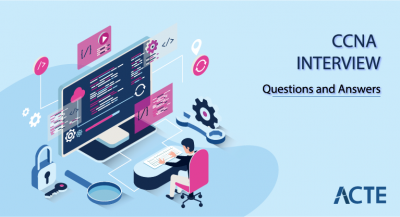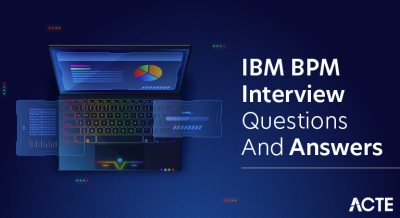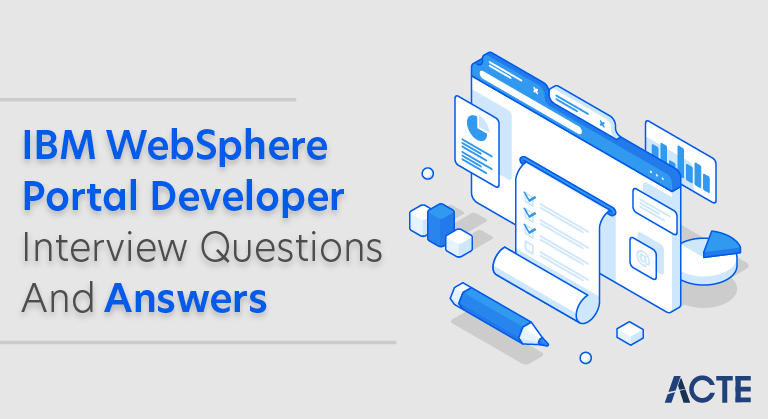
These IBM WebSphere Portal Developer Interview Questions have been designed specially to get you acquainted with the nature of questions you may encounter during your interview for the subject of IBM WebSphere Portal Developer. As per my experience good interviewers hardly plan to ask any particular question during your interview, normally questions start with some basic concept of the subject and later they continue based on further discussion and what you answer.we are going to cover top 100 IBM WebSphere Portal Developer Interview questions along with their detailed answers. We will be covering IBM WebSphere Portal Developer scenario based interview questions, IBM WebSphere Portal Developer interview questions for freshers as well as IBM WebSphere Portal Developer interview questions and answers for experienced.
1. What is IBM WebSphere Portal?
Ans:
IBM WebSphere Portal is a framework for creating unified web portals that offer centralized access to enterprise applications, fostering integration and collaboration by providing a consolidated platform for users to interact with diverse content and services.
2. Explain the key features of IBM WebSphere Portal.
Ans:
Portlet Development : Allows the creation of modular and pluggable user interface components.
Personalization : Supports robust personalization based on user preferences and contextual information.
Content Management : Includes a web content management system for creating, publishing, and managing digital content.
Integration : Facilitates seamless integration with enterprise applications, databases, and services, promoting interoperability and data exchange.
3. Differentiate between WebSphere Portal and WebSphere Application Server.
Ans:
Purpose : WebSphere Portal focuses on building and managing web portals, while WebSphere Application Server hosts and executes Java-based applications.
Functionality : Portal handles content aggregation, personalization, and collaboration, while Application Server manages the execution of Java applications.
User Interface : Portal emphasizes user interfaces with features like portlets, whereas Application Server focuses on backend application logic.
Content Management : WebSphere Portal includes content management features not central to WebSphere Application Server’s primary functions.
4. What is a portlet in the context of IBM WebSphere Portal?
Ans:
A portlet in IBM WebSphere Portal is a modular, pluggable user interface component. These small units of functionality can be assembled to create complete portal pages, allowing for flexibility and customization in presenting content and services to users within the portal framework.
5. Can you explain the role of WebSphere Portal in a typical enterprise architecture?
Ans:
In a typical enterprise architecture, WebSphere Portal serves as a unified access point, aggregating and presenting diverse content, applications, and services. It facilitates seamless integration, collaboration, and personalized user experiences, making it a key component for enhancing communication and interaction within the organization.
6. Describe the components of WebSphere Portal architecture.
Ans:
Portlet Container : Manages the lifecycle and rendering of portlets.
Web Content Management : Supports the creation, publishing, and management of digital content.
Personalization Engine : Enables customization of portal content based on user preferences.
Security Infrastructure : Includes features like authentication, authorization, and Single Sign-On for secure access.
Integration Services : Facilitates seamless integration with enterprise applications, databases, and services.
7. What is the purpose of the WebSphere Portal theme?
Ans:
The WebSphere Portal theme defines the visual appearance of the portal, encompassing elements like colors, layouts, and styles. It allows organizations to customize the portal’s look and feel, aligning it with branding and user experience preferences.
8. Explain the concept of Personalization in IBM WebSphere Portal.
Ans:
Personalization in WebSphere Portal involves tailoring the user experience based on individual preferences and contextual information. It enables users to customize their portal interactions, content, and layouts, fostering a more personalized and engaging experience.
9. How does Single Sign-On (SSO) work in WebSphere Portal?
Ans:
Single Sign-On in WebSphere Portal streamlines user access by allowing them to log in once and gain access to multiple applications and services without the need to reauthenticate. It enhances user convenience, reduces password fatigue, and improves overall security by centralizing authentication processes.
10. What is the WebSphere Portal Page Hierarchy?
Ans:
The Page Hierarchy in WebSphere Portal organizes content through pages, serving as containers for portlets and other elements. It allows for a structured arrangement of pages, facilitating a logical presentation of content within the portal.
11. How can you integrate external applications into WebSphere Portal?
Ans:
External applications can be integrated into WebSphere Portal through portlets or by using various integration techniques. This enables seamless access and interaction with external services, enhancing the portal’s functionality and providing users with a unified experience.
12. Explain the role of WebSphere Portlet Factory in portal development.
Ans:
WebSphere Portlet Factory plays a crucial role in portal development by providing a visual development environment. It allows developers to create portlets without extensive coding, utilizing a model-driven approach. This accelerates the development process, making it more efficient and accessible for developers with varying skill levels.
13. What are the different types of portlets supported by WebSphere Portal?
Ans:
WebSphere Portal supports various portlet types, including web-based, JSR 286 standard, and IBM iWidget portlets. This flexibility enables developers to create and integrate diverse and specialized portlet functionalities within the portal environment.
14. What is the purpose of the WebSphere Portal Catalog?
Ans:
The WebSphere Portal Catalog serves as a centralized repository for reusable assets, such as portlets, themes, and templates. It provides a structured way to manage and share these assets across the portal, promoting consistency and efficiency in development.
15. How do you deploy portlets in WebSphere Portal?
Ans:
Portlets in WebSphere Portal can be deployed through the administrative console or command-line tools. Deployment involves packaging the portlet into a WAR (Web Application Archive) file and then deploying it to the portal server. This process ensures the proper integration and functioning of the portlet within the portal environment.
16. Explain the difference between Virtual Portals and Regular Portals.
Ans:
| Aspect | Virtual Portals | Regular Portals | |
| Definition |
Created within a single portal |
Standalone portals. | |
| Scope | Share resources and themes | Independent resource and themes. | |
| Customization | Customizable for different groups. | Uniform appearance. |
17. What is the use of the Page Layout component in WebSphere Portal?
Ans:
The Page Layout component in WebSphere Portal is essential for organizing and structuring content on portal pages. It defines the arrangement of portlets and content, providing a framework for creating consistent and visually appealing page layouts tailored to the needs of users.
18. How does caching work in WebSphere Portal?
Ans:
WebSphere Portal uses caching to enhance performance by storing frequently accessed data temporarily. This can include rendered portlet output, database queries, and other content. Caching reduces the need for repetitive processing, resulting in faster response times and improved overall portal efficiency.
19. Explain the role of the XML Access interface in WebSphere Portal administration.
Ans:
The XML Access interface in WebSphere Portal administration serves as a tool for managing and configuring portal resources through XML scripts. It enables administrators to automate tasks such as creating and updating portal pages, portlets, themes, and other elements, streamlining the configuration and deployment processes.
20. What is the purpose of the Resource Environment Provider in WebSphere Portal?
Ans:
The Resource Environment Provider in WebSphere Portal is responsible for managing external resources such as database connections, providing a standardized way to configure and access these resources. It enhances the portal’s ability to integrate with external systems, ensuring efficient utilization and management of critical resources.
21. Describe the role of the Web Content Manager in WebSphere Portal?
Ans:
The Web Content Manager in WebSphere Portal is a component dedicated to the creation, management, and presentation of digital content. It enables users to author, collaborate on, and publish content seamlessly within the portal. This ensures a dynamic and engaging user experience by allowing efficient management and delivery of relevant and up-to-date information.
22. How do you troubleshoot performance issues in WebSphere Portal?
Ans:
To troubleshoot performance issues in WebSphere Portal, administrators can use monitoring tools like IBM Health Center, analyze log files, and utilize performance tuning parameters. Identifying and optimizing slow-performing portlets, tuning database connections, and ensuring proper resource allocation can also help address performance bottlenecks.
23. What is the purpose of the XML Configuration Interface (XCI) in WebSphere Portal?
Ans:
The XML Configuration Interface (XCI) in WebSphere Portal facilitates the configuration and customization of portal settings through XML files. It provides a standardized and flexible approach to manage various aspects of portal configuration, including themes, portlets, and page layouts, allowing administrators to make changes efficiently and consistently.
24. Explain the process of creating a new theme in WebSphere Portal.
Ans:
To create a new theme in WebSphere Portal, developers typically follow these steps :
- Define the theme’s structure and layout using theme artifacts.
- Customize the theme’s appearance by specifying styles, images, and other visual elements.
- Package the theme into a ThemeWAR file.
- Deploy the ThemeWAR file through the WebSphere Portal Administration Console.
25. How can you enable search functionality in WebSphere Portal?
Ans:
- Integrate with a search engine like IBM Watson Explorer.
- Configure portal settings for the chosen search engine.
- Set up indexing for content to enable effective search.
- Ensure proper permissions for users to access search results.
- Utilize search components compatible with WebSphere Portal.
26. What is the purpose of the WebSphere Portal Scripting Interface?
Ans:
- Facilitates automation and customization of portal tasks.
- Enables scripting using languages like JavaScript.
- Allows manipulation of portal elements and behavior.
- Useful for dynamic content updates and user interactions.
- Enhances flexibility in portal administration and development.
27. How does WebSphere Portal support multilingual content?
Ans:
- Supports content translation for multiple languages.
- Utilizes language-specific resource bundles.
- Allows administrators to define language preferences.
- Provides localization options for portlets and themes.
- Enables dynamic rendering based on user language settings.
28. What are the key security features in WebSphere Portal?
Ans:
Authentication : Supports LDAP, custom registry, and SSO.
Authorization : Granular control via roles and permissions.
SSL/TLS Support : Ensures secure data transmission.
Security Domains : Segregates users and resources.
29. Explain the role of the Virtual Member Manager (VMM) in WebSphere Portal.
Ans:
User Management : Manages user identities and profiles.
Integration : Integrates with various identity sources.
Custom Attributes : Allows definition of additional user attributes.
Authentication : Supports multiple authentication mechanisms.
Single Sign-On (SSO) : Enables seamless access across applications.
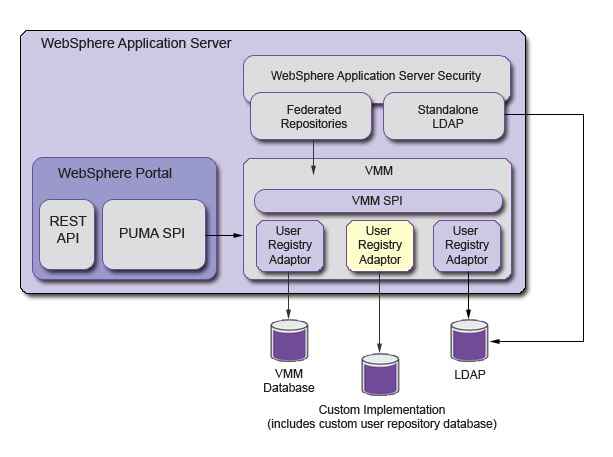
30. What is the purpose of the Credential Vault in WebSphere Portal?
Ans:
Secure Storage : Safely stores sensitive credentials and keys.
Encryption : Protects stored credentials using encryption.
Integration : Integrates with various authentication systems.
Single Sign-On (SSO) : Supports SSO mechanisms securely.
Access Control : Ensures restricted access to stored credentials.
31. How can you customize user authentication in WebSphere Portal?
Ans:
- Use custom filters or plug-ins for authentication.
- Integrate external identity providers with SAML or LDAP.
- Implement custom login modules for advanced processes.
- Configure authentication via WebSphere Application Server.
- Leverage JAAS for additional customization.
32. Describe the role of the Page Builder in WebSphere Portal.
Ans:
- Page Builder is vital for content creation and management.
- Allows users to assemble personalized pages.
- Offers a drag-and-drop interface for ease of use.
- Supports dynamic content integration on portal pages.
- Facilitates the creation of customized user experiences.
33. How does the WebSphere Portal integration with IBM Connections work?
Ans:
- Integrates seamlessly for enhanced collaboration.
- Allows embedding of Connections components in portal pages.
- Facilitates sharing content between the two platforms.
- Supports single sign-on for a unified user experience.
- Enables access to social collaboration features within the portal.
34. What is the purpose of the WebSphere Portal Accelerators?
Ans:
- Accelerators are pre-built components for rapid portal development.
- They address common use cases and industry-specific needs.
- Serve to expedite portal deployment with ready-made solutions.
- Enhance development efficiency by providing reusable functionalities.
- Cover a range of features, such as collaboration, content management, and more.
35. How can you migrate content between different WebSphere Portal environments?
Ans:
- Use the IBM® Web Content Manager tool for content migration.
- Export and import content packages between environments.
- Leverage deployment descriptors to manage configurations.
- Employ the Digital Experience Configuration Migration tool.
- Ensure compatibility and version consistency during migration.
36. Explain the role of the IBM WebSphere Portal Mashup Center.
Ans:
- Mashup Center facilitates the creation of composite applications.
- Integrates data, widgets, and services from diverse sources.
- Enables non-developers to create mashups using a visual interface.
- Supports the aggregation of content from web applications.
- Enhances collaboration and data visualization in portal environments.
37. What is the purpose of the WebSphere Portal Access Control model?
Ans:
- Governs user access to portal resources.
- Ensures secure interactions via roles and permissions.
- Manages permissions for users and user groups.
- Enhances security and controls within the portal environment.
38. How do you handle versioning of portlets in WebSphere Portal?
Ans:
- Use the versioning feature in WebSphere Portal.
- Create and manage versions of portlets.
- Facilitates development, testing, and deployment phases.
- Ensures seamless transitions and rollback options.
39. Explain the significance of the URL mapping in WebSphere Portal.
Ans:
- URL mapping customizes portal URLs for user-friendly access.
- Enhances SEO and provides cleaner, more readable URLs.
- Supports branding and improves user experience.
- Allows for consistent URL patterns across the portal.
40. How can you integrate WebSphere Portal with IBM WebSphere MQ?
Ans:
- Use the WebSphere MQ resource adapter for integration.
- Configure connection factories and queues.
- Establish J2C authentication aliases for secure communication.
- Leverage IBM WebSphere MQ messaging provider for seamless integration.
41. Describe the process of creating and managing portlet preferences.
Ans:
- Define preferences in the portlet deployment descriptor.
- Use the PortletPreferences API to access and modify preferences.
- Manage user-specific configurations through the user interface.
- Store and retrieve portlet preferences persistently for user customization.
42. What is the purpose of the WebSphere Portal Script Application?
Ans:
- Enables automation and customization of portal tasks.
- Provides a scripting interface using languages like JavaScript.
- Facilitates dynamic content updates and user interactions.
- Enhances flexibility in portal administration and development.
43. How do you implement responsive design in WebSphere Portal?
Ans:
- Utilize responsive design frameworks such as Bootstrap or Foundation.
- Design fluid grid layouts and implement flexible media queries.
- Use CSS3 media queries to adapt portal content to various devices.
- Leverage the WebSphere Portal Theme for customization and styling.
- Ensure a seamless user experience across desktop, tablet, and mobile devices.
44. Explain the role of the Content Template Catalog (CTC) in WebSphere Portal.
Ans:
- CTC streamlines content creation by offering pre-built templates.
- Provides a repository of reusable content templates for consistent design.
- Enables content authors to create dynamic and engaging pages.
- Enhances efficiency by reducing the effort required for content creation.
- Facilitates the creation of standardized and visually appealing content.
45. How can you integrate WebSphere Portal with LDAP for user authentication?
Ans:
- Configure LDAP settings in WebSphere Portal’s administrative console.
- Specify LDAP server details, including host, port, and security settings.
- Map LDAP attributes to portal user attributes for seamless integration.
- Test the LDAP configuration to ensure successful connectivity.
- Enable LDAP as an authentication option for portal users.
- Users can now authenticate against the LDAP directory when accessing the portal.
46. What is the purpose of the WebSphere Portal Mobile Experience?
Ans:
- Enhances mobile accessibility for WebSphere Portal.
- Provides responsive design and device-specific layouts.
- Aims to optimize user experience on mobile devices.
- Enables the creation of mobile-friendly portals and applications.
- Enhances usability and engagement for mobile users.
47. How does the WebSphere Portal support social collaboration features?
Ans:
- Integrates with IBM Connections for social capabilities.
- Enables sharing, commenting, and liking of portal content.
- Supports activity streams for real-time updates.
- Facilitates collaborative document editing and sharing.
- Enhances communication and engagement among portal users.
48. Explain the role of the Theme Customizer in WebSphere Portal.
Ans:
- Theme Customizer allows visual customization of portal themes.
- Empowers administrators to modify colors, fonts, and layouts.
- Provides a user-friendly interface for theme adjustments.
- Enhances branding by tailoring the portal’s look and feel.
- Supports customization without deep technical expertise.
49. How do you configure WebSphere Portal to work with a load balancer?
Ans:
- Set up the load balancer for distributing requests across portal servers.
- Configure session affinity to maintain consistent user sessions.
- Align virtual hosts and portal URLs with load balancer settings.
- Update WebSphere Portal configuration files to reflect load balancer details.
- Implement secure communication between the load balancer and portal servers.
50. What are the best practices for optimizing performance in WebSphere Portal development?
Ans:
- Implement caching mechanisms for frequently accessed content.
- Optimize database queries to ensure efficient resource usage.
- Prefer lightweight themes to minimize page load times.
- Utilize compression for transmitted data to reduce bandwidth requirements.
- Monitor and optimize server and JVM settings for optimal performance.
51. What is the primary purpose of IBM WebSphere Portal?
Ans:
IBM WebSphere Portal is a platform for building enterprise web portals, providing a unified access point for applications and content to enhance collaboration and user experiences.
52. Explain the concept of portlets in the context of WebSphere Portal.
Ans:
Portlets are modular components in WebSphere Portal, independently generating content or functionality, contributing to interactive and customizable web pages.
53. How does WebSphere Portal handle user authentication and authorization?
Ans:
WebSphere Portal supports diverse authentication methods, ensuring secure user access. Authorization is managed through roles and permissions, controlling user privileges within the portal environment.
54. Can you describe the key components of a portlet application in WebSphere Portal?
Ans:
- Portlet applications in WebSphere Portal consist of a Java class for logic, deployment descriptor, and portlet artifacts.
- The Java class implements portlet functionality, and the deployment descriptor defines the portlet’s characteristics.
- Portlet artifacts, such as images or stylesheets, contribute to the overall presentation.
55. What is the difference between public and private render parameters in portlet communication?
Ans:
- Public render parameters allow communication between different portlets on a page.
- Private render parameters are specific to a single portlet and are not shared with others.
- Public parameters are declared in the portlet.xml file and can be used by any portlet on the page.
- Private parameters are declared in the portlet Java code and are limited to the declaring portlet’s use.
56. How do you configure single sign-on (SSO) in WebSphere Portal?
Ans:
- Configure WebSphere Portal as an SSO service provider or relying party.
- Integrate with an identity provider (IdP) that supports SSO, such as IBM Tivoli Federated Identity Manager.
- Establish trust between the portal and the IdP by exchanging metadata.
- Configure SSO settings in WebSphere Portal, specifying IdP details.
57. What is the significance of the XML Access Interface in WebSphere Portal?
Ans:
- XML Access Interface is a command-line utility in WebSphere Portal.
- It manages portal configurations by importing/exporting them in XML format.
- Essential for automating deployment processes and maintaining configuration consistency.
- Enables efficient management of portal resources, pages, and settings.
58. Explain the role of the WebSphere Portal Theme and how it can be customized.
Ans:
- WebSphere Portal Theme defines the visual aspects of the portal, including layout and styles.
- Crucial for shaping the portal’s look and feel, contributing to the user experience.
- Customization involves adjusting CSS files, images, and layout settings.
- Themes can align with branding, corporate guidelines, or user preferences.
- A key element in creating a distinctive and personalized visual identity for the WebSphere Portal.
59. How can you create a new theme in WebSphere Portal?
Ans:
WebSphere Portal Theme defines the visual aspects of the portal, including layout and styles. Crucial for shaping the portal’s look and feel, contributing to the user experience. Customization involves adjusting CSS files, images, and layout settings. Themes can align with branding, corporate guidelines, or user preferences. A key element in creating a distinctive and personalized visual identity for the WebSphere Portal.
60. Describe the steps to create a new page template in WebSphere Portal.
Ans:
- To create a new theme, start by defining the theme in a theme descriptor file (XML).
- Specify theme settings such as colors, fonts, and layout characteristics.
- Include custom CSS files and images to tailor the visual appearance.
- Package the theme as a theme module (WAR file) for deployment.
- Upload and configure the new theme through the WebSphere Portal Administration Console.
61. How can you use the Credential Vault to enhance security in WebSphere Portal?
Ans:
- Open WebSphere Portal Administration Console.
- Navigate to “Templates” and choose “Page Templates.”
- Initiate the creation of a new template.
- Define properties, layout, and theme.
- Configure sections and layout containers.
- Save and deploy the template for use in portal pages.
62. What are Virtual Portlet Factory and Virtual Portal Factory, and how do they differ?
Ans:
- Access WebSphere Portal Administration Console.
- Navigate to “Resources” and select “Security.”
- Create a new credential slot.
- Store sensitive data securely in the Credential Vault.
- Configure applications to retrieve credentials during runtime.
63. What is the importance of URL mapping in WebSphere Portal?
Ans:
Virtual Portlet Factory (VPF) :
- Creates portlets without traditional coding.
- Uses a visual interface for assembly.
- Supports data integration and transformation.
- Ideal for users with limited coding skills.
Virtual Portal Factory (VPF) :
- A tool for creating entire virtual portals.
- Assembles portals without extensive coding.
- Offers visual tools for portal configuration.
64. How does WebSphere Portal support content management and collaboration?
Ans:
- WebSphere Portal integrates with IBM Web Content Manager for content management.
- It facilitates collaborative content creation, editing, and sharing.
- Supports versioning and workflow processes for content control.
- Integration with IBM Connections enhances social collaboration features.
- Enables seamless embedding of collaboration tools within portal pages.
65. What is the significance of the Page Builder in WebSphere Portal?
Ans:
- Page Builder is a key component for creating and managing portal content.
- It offers a user-friendly, drag-and-drop interface for assembling pages.
- Allows users to customize and personalize their portal pages dynamically.
- Supports the integration of various portlets and content elements.
- Enhances flexibility by empowering users in content arrangement.
66. Describe the steps to integrate WebSphere Portal with IBM WebSphere MQ.
Ans:
- Configure the WebSphere MQ resource adapter in the WebSphere Portal environment.
- Specify connection factories and queues for communication.
- Establish J2C authentication aliases for secure interactions.
- Leverage the IBM WebSphere MQ messaging provider for seamless integration.
- Ensure proper configuration of connection details and security settings.
67. How does WebSphere Portal handle multilingual content?
Ans:
- Utilize the Language portlet to enable language selection for users.
- Create language-specific versions of portal pages and content.
- Leverage the Web Content Viewer portlet to display content in different languages.
- Configure language settings in the portal’s administrative console.
- Enable multilingual support for portlet preferences and user profiles.
68. Explain the purpose of WebSphere Portal Accelerators.
Ans:
- WebSphere Portal Accelerators are pre-built components and applications.
- They expedite portal development and deployment by addressing common use cases.
- Accelerators offer ready-made solutions for collaboration, content management, and more.
- Enhance development efficiency by providing reusable functionalities.
- Cover a range of features to streamline and simplify portal implementation.
69. What is the purpose of the Theme Customizer in WebSphere Portal?
Ans:
- The Theme Customizer in WebSphere Portal facilitates visual customization of portal themes.
- Administrators can modify colors, fonts, and layout settings through a user-friendly interface.
- It empowers customization without requiring in-depth technical expertise.
- Theme Customizer enhances branding by allowing the tailoring of the portal’s visual identity.
70. What is the function of the WebSphere Portal Script Application?
Ans:
- The WebSphere Portal Script Application provides a scripting interface for portal tasks.
- It allows automation and customization using languages like JavaScript.
- Scripting capabilities enhance dynamic content updates and user interactions.
- WebSphere Portal Script Application empowers flexibility in portal administration and development.
- Enables the creation of dynamic, responsive, and interactive portal elements.
71. How can responsive design be implemented in WebSphere Portal?
Ans:
- Design fluid grid layouts and implement flexible media queries.
- Use CSS3 media queries to adapt portal content to various devices.
- Leverage the WebSphere Portal Theme for responsive layout customization.
- Ensure a seamless user experience across desktop, tablet, and mobile devices.
- Test and optimize responsiveness for different screen sizes and resolutions.
72. Explain the key components of IBM WebSphere Portal.
Ans:
IBM WebSphere Portal consists of essential components. The Portal Server serves as the runtime environment, managing applications and user requests. The Portal Database stores configuration data and user profiles. Portlets are modular components rendering content, while Themes define the portal’s appearance. The Web Content Management (WCM) system efficiently handles content, and the Personalization Engine customizes content based on user profiles and behavior. These components collectively empower the development and deployment of versatile enterprise portal applications.
73. What is the function of the WebSphere Portal Script Application?
Ans:
- The WebSphere Portal Script Application provides a scripting interface for portal tasks.
- It allows automation and customization using languages like JavaScript.
- Scripting capabilities enhance dynamic content updates and user interactions.
- WebSphere Portal Script Application empowers flexibility in portal administration and development.
74. How can responsive design be implemented in WebSphere Portal?
Ans:
- Design fluid grid layouts and implement flexible media queries.
- Use CSS3 media queries to adapt portal content to various devices.
- Leverage the WebSphere Portal Theme for responsive layout customization.
- Ensure a seamless user experience across desktop, tablet, and mobile devices.
- Test and optimize responsiveness for different screen sizes and resolutions.
75. Describe the steps involved in migrating content between different WebSphere Portal environments.
Ans:
- Export content from the source portal using tools like XMLAccess or Content Template Catalog.
- Transfer exported content to the target portal environment.
- Import the content into the target portal using appropriate tools.
- Verify and validate the migrated content for consistency and integrity.
76. What are the security considerations when configuring WebSphere Portal with a load balancer?
Ans:
- Use secure communication (HTTPS) between the load balancer and portal servers.
- Configure load balancer settings to support session affinity for consistent user sessions.
- Implement proper encryption and authentication protocols.
- Regularly update and patch the load balancer for security fixes.
77. How can you enforce access control for portal resources in WebSphere Portal?
Ans:
- Utilize the WebSphere Portal access control model to define roles and permissions.
- Assign users or groups to specific roles based on their responsibilities.
- Configure fine-grained access control for portal resources, including pages and portlets.
- Leverage Virtual Member Manager (VMM) for user and group management.
78. Explain the role of caching in optimizing WebSphere Portal performance.
Ans:
- Caching involves storing frequently accessed data to reduce redundant processing.
- WebSphere Portal utilizes caching to store portal content, fragments, and portlet output.
- Caching minimizes the need for recalculating or fetching data from external sources.
- It significantly improves response times and reduces server loads.
79. What is the purpose of the IBM Web Content Manager tool in WebSphere Portal?
Ans:
- IBM Web Content Manager (WCM) is a content management tool integrated into WebSphere Portal.
- WCM enables the creation, management, and publication of web content.
- It supports versioning, workflow, and collaboration for efficient content development.
- WCM facilitates the integration of dynamic and personalized content within portal pages.
80. How do you create a new page in WebSphere Portal using XML configuration?
Ans:
- Define the new page’s structure and attributes in an XML configuration file.
- Specify details such as page name, layout, and theme in the XML file.
- Use XML elements to describe the placement of portlets and content on the new page.
- Save and deploy the XML configuration file to the WebSphere Portal environment.
- Verify the new page’s availability and appearance through the portal interface.
81. Can you describe the differences between WebSphere Portal and WebSphere Application Server?
Ans:
WebSphere Portal :
- Specialized for building and managing web portals.
- Includes features for content management, collaboration, and personalization.
- Emphasizes creating user-centric and interactive web experiences.
WebSphere Application Server :
- General-purpose application server for Java applications.
- Focuses on hosting and executing Java EE-based applications.
- Primarily concerned with application deployment, execution, and scalability.
82. How does WebSphere Portal handle session management for portlet applications?
Ans:
- WebSphere Portal uses the underlying Java EE session management mechanisms.
- Manages sessions through the HttpSession object in the servlet API.
- Portlet applications leverage the HttpSession for user-specific data storage.
- Supports session clustering for scalability and failover.
83. What is the role of the Portlet Service Manager in WebSphere Portal?
Ans:
- Portlet Service Manager manages portlet services and their life cycles.
- Coordinates the initialization and destruction of portlet services.
- Ensures proper communication between portlets and the portal container.
- Facilitates the sharing of services across multiple portlets.
- Centralizes the management of common functionalities used by portlets.
84. How do you configure the logging settings for WebSphere Portal?
Ans:
- Access the WebSphere Portal Administration Console.
- Navigate to “Troubleshooting” and select “Logs and Trace.”
- Configure log levels, log file locations, and rotation settings.
- Specify trace specifications for detailed diagnostic information.
85. Explain the process of creating a custom portlet in WebSphere Portal.
Ans:
- Develop the portlet logic using Java and the Portlet API.
- Create a portlet deployment descriptor (portlet.xml) defining the portlet’s characteristics.
- Package the portlet as a WAR file with the necessary resources.
- Deploy the custom portlet through the WebSphere Portal Administration Console.
86. What are the key considerations when designing portal navigation in WebSphere Portal?
Ans:
- Analyze user roles and tasks to determine navigation requirements.
- Create a clear and intuitive information architecture for the portal.
- Utilize hierarchical menus, breadcrumbs, and navigation portlets for easy traversal.
- Implement responsive design to accommodate various devices and screen sizes.
- Ensure consistent and standardized navigation across portal pages.
87. How can you implement custom navigation menus in WebSphere Portal?
Ans:
- Use the Page Hierarchy portlet or custom navigation portlets for menu creation.
- Develop custom themes to style and control the layout of navigation elements.
- Utilize navigation APIs to dynamically generate menu content.
- Leverage portal navigation models to retrieve and display navigation links.
- Customize CSS and JavaScript to enhance the visual appearance and interactivity.
88. What is the purpose of the WebSphere Portal Express Edition?
Ans:
- WebSphere Portal Express Edition is a streamlined version of WebSphere Portal.
- Tailored for small to medium-sized businesses with fewer advanced features.
- Offers essential portal capabilities, including content management and collaboration.
- Provides a cost-effective solution for organizations with modest portal requirements.
89. Describe the steps to enable SSL for secure communication in WebSphere Portal.
Ans:
- Obtain and install an SSL certificate from a trusted certificate authority.
- Access the WebSphere Portal Administration Console.
- Navigate to “Security” and configure the SSL certificate for the portal.
- Update virtual hosts and port configurations to use the SSL protocol.
- Configure the IBM HTTP Server (if used) to support SSL.
90. How do you customize error pages in WebSphere Portal?
Ans:
- Access the WebSphere Portal Administration Console.
- Navigate to “Virtual Portals” and choose the desired virtual portal.
- Go to “Error Pages” to customize pages for different HTTP status codes.
- Modify the HTML content, layout, and styles to tailor error messages.
- Ensure consistency with the portal’s look and feel for a seamless user experience.


